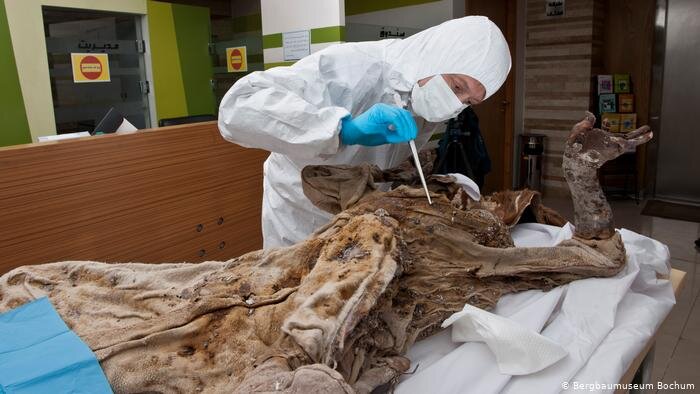Parallel loan exhibits on ancient mining start in Iran, Germany

TEHRAN – On Wednesday, two separate loan exhibitions featuring ancient mining and relevant documents were kicked off in Iran and Germany.
The opening ceremonies were conducted online simultaneously at the National Museum of Iran, and Deutsches Bergbau-Museum Bochum (The German Mining Museum in Bochum).
The exhibition hosted by the German Mining Museum in Bochum is titled “Death in Salt, an Archaeological Narrative of the Land of Persia” and the other is named “Human Search for Resources.”
Jebrael Nokandeh, the director of the National Museum, said: “The National Museum of Iran and the German Mining Museum in Bochum have cooperation in line with the MOU signed in 2017.” The two museums have sought to hold exhibitions of each other's historical and cultural artifacts related to the subject of ancient mining.
He continued: “Due to the continuing limitations caused by the pandemic, the exhibitions will be accessible virtually simultaneously through the websites of both museums for visitors around the world.”
Regarding the exhibition of the Iranian collection, the official said: The virtual exhibition “Death in Salt, an Archaeological Narrative of the Land of Persia” deals with archeological research and findings of the Chehrabad salt mine in Zanjan, which is available on the German Mine Museum website in Bochum.
Regarding the exhibition “Human Search for Resources”, he said: The exhibition can be viewed online on the website of the National Museum of Iran. In this exhibition, more than 200 objects related to mining history from twenty countries of the world have been displayed. This collection covers a very long history starting with Paleolithic objects up to the contemporary period.
He reminded: These virtual exhibitions will be opened simultaneously in Iran and Germany with the presence of cultural officials of the two countries on April 7, 2021, at 18:30, and this ceremony will be covered live on the official Instagram page of the National Museum of Iran.
Explaining the goals of this virtual international cultural event, Nokandeh said: “Holding two-sided exhibitions became one of the important activities of the National Museum of Iran in recent years, and due to the pandemic and its limitations, the cooperation of museums has continued in a virtual format.” On the other hand, holding such events reflects the role of museums, that is, their healing presence in crises, which is to create a sense of calmness and security in the face of the shadow of bitter social experiences.
Iran’s tourism minister Ali-Asghar Mounesan announced in December that some 200 works, which were on loan from German’s Deutsches Bergbau-Museum Bochum, had been transferred to Tehran to go on show at the National Museum. “The exhibit will be featuring the history of mining in the world from the Stone Age to recent centuries, whose works are from 20 different countries on five continents,” the minister said.
Last year, a team of experts from the two countries started a project for purifying, cleansing, and restoring garments and personal belongings of the mummies which were first found in the salt mine in 1993. What was a catastrophe for the ancient miners has become a sensation for science. Sporting a long white beard, iron knives, and a single gold earring, the first salt mummy was discovered in 1993. He is estimated to be trapped in the mine in ca. 300 CE. In 2004 another mummy was discovered only 50 feet away, followed by another in 2005 and a “teenage” boy mummy later that year.
In 1993, miners in the Douzlakh Salt Mine, near Hamzehli and Chehrabad villages in Zanjan province, accidentally came across a mummified head. The head was very well preserved, to the extent that his pierced ear was still holding the gold earring. The hair, beard, and mustaches were reddish, and his impressive leather boot still contained parts of his leg and foot, according to Ancient History Encyclopedia.
The first mummy, dubbed the “Saltman”, is on display in the National Museum of Iran in Tehran. He still looks very impressive. The third, fourth, and fifth “saltmen” were also carbon dated. The third body was dated and placed in 2337 BP, the fourth body in 2301 BP, and the fifth mummy was dated to 2286 BP, placing them all in the Achaemenid period.
The isotopic analysis of the human remains revealed where these miners were from. Some of them were from the Tehran-Qazvin plain, which is relatively local to the mine’s locality, while others were from north-eastern Iran and the coastal areas around the Caspian Sea, and a few from as far away as Central Asia.
Furthermore, the archaeozoological finds, such as animal bones found within the context of the saltmen, showed that the miners might have eaten sheep, goats, and probably pigs and cattle, as well. The archaeobotanical finds recorded showed different cultivated plants were eaten, indicating an agricultural establishment in the vicinity of the mine.
The wealth of fabric and other organic material (leather) worn by the saltmen have allowed a thorough analysis to be undertaken, detailing the resources used to make the fabrics, the processing, the dyes used to color the fibers of the garments, and not least they offer an excellent overview of the changes in cloth types, patterns of weaving, and the changes of the fibers through time.
Saltman No. 5 had tapeworm eggs from the Taenia sp. genus in his system. These were identified during the study of his remains. The find indicates the consumption of raw or undercooked meat, and this is the first case of this parasite in ancient Iran and the earliest evidence of ancient intestinal parasites in the area. The best preserved and probably the most harrowing of the saltmen is Saltman No. 4. A sixteen-year-old miner, caught in the moment of death, crushed by a cave-in.
AFM/
Leave a Comment